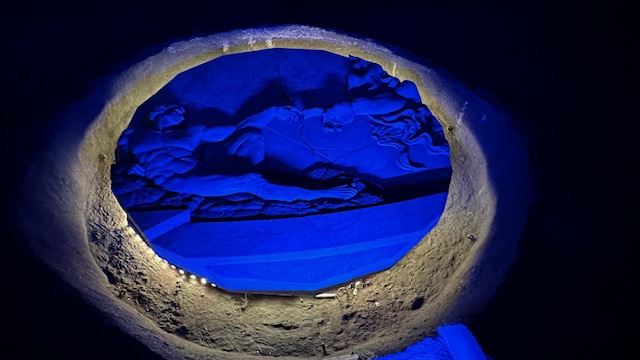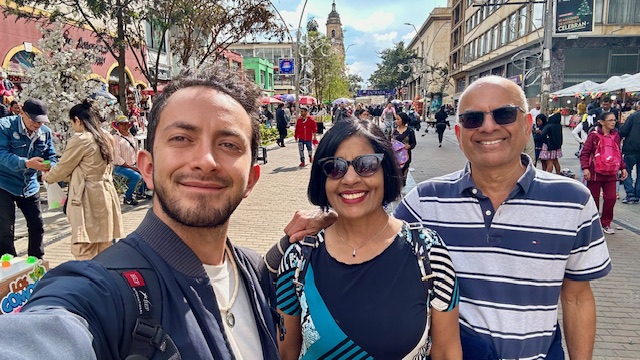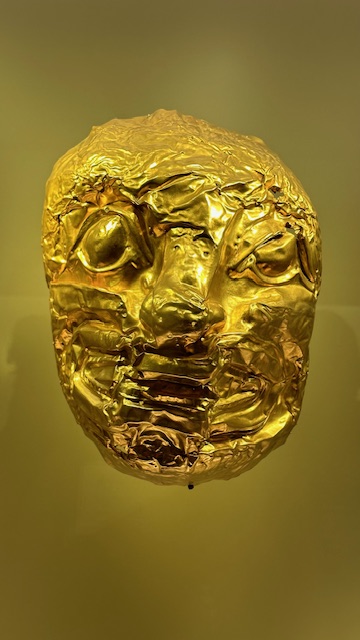Day 1
We had booked a viator day trip to Zipaquira Salt Cathedral at 10am. The tour guide came 5 min early and we were on our way. About 50 km from Bogotá, the Salt Cathedral in the town of Zipaquirá is a Roman Catholic church built in the shaft of an abandoned halite salt mine 200 meters underground. It is both a tourist attraction and a site of pilgrimage. Weddings are also held here.
You enter the mine through an original fortified tunnel, which then opens up to a shaft that has 14 stations of the cross all carved out of salt, representing Jesus’ last journey. The cross are all lit up beautifully with changing colored lights. You will then make your way to the main attraction, a cathedral complete with pews, a massive cross, and a spectacular marble carving in the floor. At the bottom, the temple opens up to reveal three naves representing the birth, life and death of Christ.








The tour of the whole place took us about 2 hours. You can complete it in an hour if you don’t stop to take pictures at every station.
Zipaquirá is a small town and has a plaza dominated by a church. We had lunch in a restaurant close to the main plaza, after which we walked around the main plaza.

If you are planning to visit Zipaquira from Bogota, plan on keeping aside at least 6 hours for the trip (3 hours commute + 2 hours tour of cathedral + 1 hour to check out the small town and lunch).
We asked our tour guide to drop us off at Plaza Bolívar in Bogota after our visit to Zipaquirá. We walked around the plaza looking for a cafe. We found a good one down the street from the plaza which also had some good cakes. In most cafes in Bogota, you are asked to select how you want your coffee prepared. The waiter then brings the appropriate coffee apparatus to your table and prepares the coffee in front of you.

Day 2
We had a fantastic walking tour of Bogota today, thanks to our Viator tour guide who did an amazing job. We were picked up from our hotel at 9am and driven to the first attraction of the day – Mount Monserrate. We went up the mountain in a cable car for an amazing and breathtaking view of Bogota. There is also the Sanctuary of Monserrate at the top which functions as neo-Gothic church dating from 1925. Monserrate is at an elevation of 10,341 feet (3,152 meters) above sea level. After spending an hour up here, we took the cable car back down. The rest of our tour was all walking around in the old section of the city.



We walked past a colorful graffiti filled neighborhood, where you see the graffiti on the entire front of a building or house and seem to tell a story or relate to an event. It is interesting that graffiti is legal in Colombia and there are many graffiti artists who are engaged to paint by private citizens. We saw the names/signatures of the artist on many of the graffiti’s that we saw. We passed by Parque de Los periodistas plaza.




La Candelaria neighborhood – This is the place where the city was founded in 1538, and takes its name from a Catholic chapel dedicated in honor of the Virgen de la Candelaria. The architecture and life around here is a mix of old and modern styles. Artists, students, and visitors from all over the world blend in its streets. One of the sights here is the Plaza del Chorro de Quevedo, where most days you’ll find a small pop-up market of local arts and crafts. There was a small stand in the plaza selling a drink called Chicha. It is fermented corn mixed with different fruit juice. We took a shot of this. It was really sweet and cooling. Just off the plaza heading downhill is Calle Jon del Embudo, a famous, narrow street lined with small shops and restaurants, along with some of the city’s most famous murals.






We then stopped at a marketplace to enjoy Colombian fruits. Except for Guava, I hadn’t tasted or even heard of the fruits that you see in the picture.

Big yellow fruit – Maracuya
Second biggest – Granadilla
White one – Guanabana
Green one : Mamonsillo
Pink – Guava
Right side of Maracuya – Lulo


Our next stop was the Gold Museum (Museo del Oro) – It’s well worth a stop to see some of the most remarkable pieces of this coveted mineral displayed. Spread over three floors, the museum showcases over 34,000 pieces from the pre-Hispanic era. Fascinating carvings primarily depicting women and animals are displayed, complete with descriptions in Spanish and English. In addition to gold pieces, the museum also displays pieces made from stone, ceramics, and even bones.







We passed by a few churches in the La Candelaria neighborhood. Church of Nuestra Señora de la Candelaria, often called the Iglesia de la Candelaria, is dedicated to Virgin Mary.



Our last stop on this guided tour was Plaza Bolivar – Home to the city’s most important buildings, this huge square is always filled with people and hundreds of pigeons. There is the impressive Cathedral of the Immaculate Conception which was built between 1807 and 1823 in the same place where three other churches were previously erected, all of which successively served as cathedrals for the city. There is also the Capitolio Nacional (or National Capitol), the construction of which began in 1848 and was finished in 1926. It houses both houses of the Congress of Colombia.



There are a couple of museums that is worth visiting, like the Botero Museum and Emerald Museum.
Botero Museum – This museum has Colombia’s most famous artist, Fernando Botero’s collection of sculptures. We were not able to check out this museum since it is closed on Tuesdays. The museum is a free attraction and it is worth a stop when open.
Emerald Museum – We passed by Museo Internacional De La Esmeralda which is a small museum offering raw emeralds on display & information on the gem’s history.
We felt that a 2-day visit to Bogota should be more than enough to see all the important sites. If you have only one day, you can skip visiting Zipaquira.